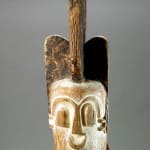Kota Wooden Emboli Helmet Mask, 20th Century CE
Wood
6.5 x 20
PF.4011 (LSO)
Further images
This striking geometric semi-helmet mask was made by the Kota (or perhaps the Kwele) group of Gabon. The basic colour of the face is white, with heavily lidded, closed eyes,...
This striking geometric semi-helmet mask was made by the Kota (or perhaps the Kwele) group of Gabon. The basic colour of the face is white, with heavily lidded, closed eyes, a nose that runs into tall brows, a smiling mouth and squared ears. The head is dominated by a high central crest running across the top of the head, with perpendicular flanges that run towards the ears. The contrast is accentuated by the dark colour of the coiffure and the pale colour of the face. The lower aspect of the mask is edged with holes for the attachment of a costume, the remnants of which are attached to the rear.
The Kota live in Eastern Gabon, and are comprised of various subunits including Ndambomo, Mahongwe, Ikota-la-hua, Sake, Menzambi and Bougom, some of which can also be differentiated artistically. Their society is largely egalitarian and gerontocratic, their economy based upon hunting and agriculture. Their relaxed social structure reflects their previous mobility – they moved into the area from the North during the 18th century – which is also perhaps the cause behind their unusual mortuary rituals in which they were basically able to take their ancestors with them wherever they went. It is also reflected in the comparatively small number of large items in their cultural repertoire, as transporting unwieldy items would have posed logistical problems.
Their masquerades are comparatively understudied but, like most African groups, contain standardised repertoires of colours and styles that denote different characters and sentiments. They are danced at initiations, and the crests are said to reflect the sagittal crests of gorillas. White is the colour of the spirits and the afterlife in many tribal groups. They are very rare as many traditional practices – including masquerades and the reliquary system – have been either suppressed or have gone out of fashion. To compound matters, many older items were intentionally destroyed in the 1940’s to 1960’s by the “Culte de Demoiselles”, who went out of their way to do away with traditional lifeways in an attempt to mimic western lifestyles.
This is a dramatic and impressive piece of African art.
The Kota live in Eastern Gabon, and are comprised of various subunits including Ndambomo, Mahongwe, Ikota-la-hua, Sake, Menzambi and Bougom, some of which can also be differentiated artistically. Their society is largely egalitarian and gerontocratic, their economy based upon hunting and agriculture. Their relaxed social structure reflects their previous mobility – they moved into the area from the North during the 18th century – which is also perhaps the cause behind their unusual mortuary rituals in which they were basically able to take their ancestors with them wherever they went. It is also reflected in the comparatively small number of large items in their cultural repertoire, as transporting unwieldy items would have posed logistical problems.
Their masquerades are comparatively understudied but, like most African groups, contain standardised repertoires of colours and styles that denote different characters and sentiments. They are danced at initiations, and the crests are said to reflect the sagittal crests of gorillas. White is the colour of the spirits and the afterlife in many tribal groups. They are very rare as many traditional practices – including masquerades and the reliquary system – have been either suppressed or have gone out of fashion. To compound matters, many older items were intentionally destroyed in the 1940’s to 1960’s by the “Culte de Demoiselles”, who went out of their way to do away with traditional lifeways in an attempt to mimic western lifestyles.
This is a dramatic and impressive piece of African art.







